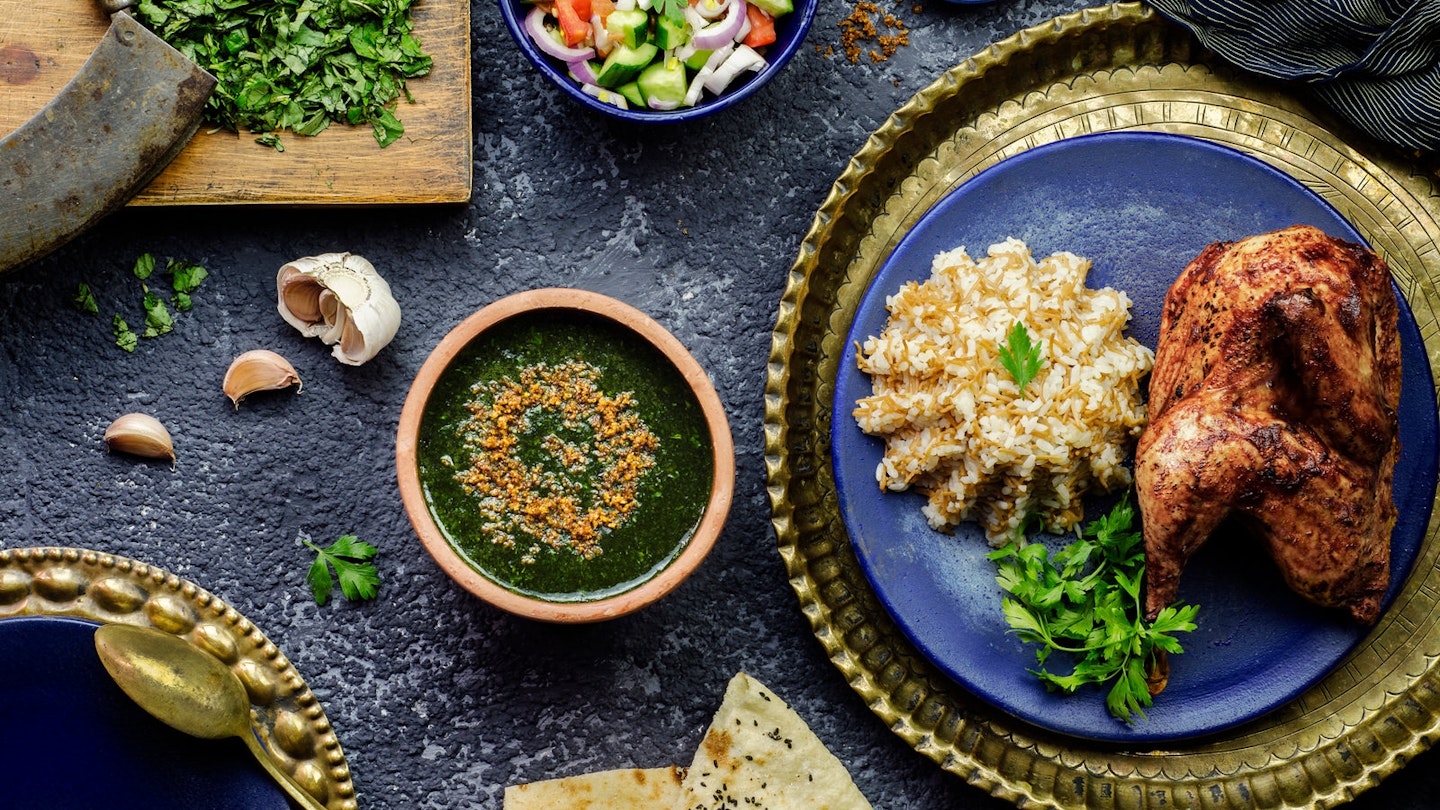Explore the Rich Cuisine of Egypt
If you know where to look, you’ll find that there is much more to Egyptian cuisine than the triumvirate of kebab, falafel, and shawarma. Sure, shish tawooq (grilled chicken) and kofta (grilled meatballs) are ubiquitous on menus, and falafel and shawarma are street food big-hitters. However, dig a bit deeper, and you’ll discover culinary traditions that often stretch all the way back to Ancient Egypt.
Molokhiyya
This viscid, dark green stew made from the leaves of the jute mallow plant (the leaves themselves are also known as molokhiyya in Egypt) vies with kushari for the title of Egypt’s national dish. It’s been around a lot longer as well, as molokhiyya leaves were a typical foodstuff in the days of the pharaohs. The stew is made by a long, slow cooking of the leaves in stock with the addition of a butter-fried blend of coriander and garlic. Many Egyptians will assure you the most important ingredient when making molokhiyya is love. Many a home chef will swear the most important point in the cooking process is making a little gasp – to pass your love into the pot – while adding the coriander and garlic mixture. Without the all-important gasp, your molokhiyya may well turn bad. Additionally, rabbit or chicken are sometimes added to the pot for a heartier stew. Whichever version you come across, molokhiyya is the one Egyptian dish that divides foreign visitors; you’ll either love it or hate it. ‘Slimy’, ‘delicious’, ‘addictive’, and ‘like licking the bottom of a swamp’ are equally common descriptions from travelers who’ve tried it.
Best Places for Molokhiyya
Ask an Egyptian who makes the best molokhiyya, and the answer will most likely be their mum, which unfortunately isn’t very helpful for travelers. Restaurants serving up decent versions of this home-cooked classic remain slim. Abou El Sid in Alexandria is a good place to try it, plus you get to dine in a piece of Alexandrian literary history, in what was once the old Pastroudis cafe. Head to Cairo Kitchen in Cairo for their molokhiyya with chicken. In Luxor, Sofra gets the thumbs up for their molokhiyya with rabbit.
Kushari
Falafel and shawarma may come to mind first when thinking about cheap eats in Egypt, but kushari is the country’s favorite fast food. A bowl of macaroni, rice, black lentils, and chickpeas, this carb-fest isn’t pretty to look at, but doused in tomato sauce, sprinkled with fried onions, and then topped up with glugs of garlicky vinegar and spicy chili sauce, kushari is cheap, filling, and completely moreish. Despite its phenomenal popularity, kushari is a relative newbie to Egyptian cuisine. Its roots are thought to be grounded in the Indian rice and lentil dish khichdi, brought to the country by European travelers in the 19th century when both Egypt and India were under British control. The recipe then evolved as cooks padded it out with legumes, onions, and sauces, and the local Italian community added pasta to the mix. Consequently, many Egyptians regard this odd but humble concoction as their national dish.
Best Places for Kushari
You’ll find specialist kushari restaurants everywhere in Egypt. Two notable spots are both in Cairo. Abu Tarek is renowned for its kushari, and its Egyptian-glitz upstairs dining hall is always bustling with families. If you prefer a spicier kick, head to Koshary Goha. The tomato sauce they serve up here has some serious heat.
Hamam Mahshi
If you spend any time traveling through the Egyptian countryside, you’ll soon spot curious dalek-shaped mudbrick buildings sitting in the fields. These are the pigeon houses used to farm the nation’s favorite delicacy. Pigeon has been eaten in Egypt since the Pharaonic age. Today the birds are most commonly served stuffed (hamam mahshi): the pigeon’s cavity is packed full of spiced freekeh (cracked green wheat) or bulgur and then grilled over charcoal. Although it’s fiddly to eat – lots of tiny bones – this doesn’t deter Egyptians who hail the dish as one of their finest.
Best Places for Hamam Mahshi
Abeer and Al Makka, both in Aswan, serve up excellent hamam mahshi and have loyal local followings. In Cairo, Farahat is the place to go. For a more sophisticated dining experience, Sofra in Luxor can’t be beaten.
Fuul Mudammas
Forget cereal and toast. Fuul mudammas (usually just shortened to fuul) is a breakfast staple in Egypt. Every Egyptian cook has their own adaptation of the recipe, but at its most basic, this dish consists of slow-cooked, mashed fava beans flavored with tomatoes, garlic, and cumin, enhanced with drizzles of olive oil and lemon juice. Today, fuul, in various guises, has become a key dish throughout the Middle East and the Horn of Africa, but its origins lay in Ancient Egypt. Within the country, fuul has specific regional variations, with fuul Iskandarani (Alexandrian style fuul: pepped up with chili, peppers, and extra spice for added zing) usually on offer no matter where you are. Fuul can be eaten as a dish itself or stuffed into pita bread for a wholesome and hearty sandwich on the run.
Best Places for Fuul Mudammas
You’ll find fuul at all the street eat spots that also serve falafel and shawarma. For the tastiest fuul, head to Mohammed Ahmed in Alexandria. This simple canteen serves up both basic fuul mudammas and fuul Iskandarani. In Cairo, stop by Zööba for contemporary twists on this classic dish, such as fuul with pickled lemon.
Fiteer
Often described as Egyptian pizza or Egyptian pie, fiteer is made from super-thin layers of flaky pastry, stuffed with a variety of different ingredients and then cooked in a brick oven. From savory versions that take the classic pizza route (filled with cheese, peppers, olives, and tomato) to sweet (honey and cream being the classic choice), there’s a fiteer for everyone. Despite the obvious comparison to pizza, fiteer is said to date back to the Pharaonic age, when this layered bread was made as an offering to the gods. Over the centuries, it has become a popular special occasion dessert. Thanks to both local and international influences, today’s flavor combinations are endless. Pizza-style versions make fiteer a savior for parents traveling with small fussy eaters, while a shawarma fiteer gives you a kebab fix wrapped up in a pastry pie.
Best Places for Fiteer
Taverna in Alexandria has a huge range of both savory and sweet fiteer, plus the chef is a master of spectacular dough stretching, so you get a show while you wait for your meal.





